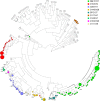Virulence factors of Shiga toxin-producing Escherichia coli and the risk of developing haemolytic uraemic syndrome in Norway, 1992-2013
- PMID: 28391537
- PMCID: PMC5554284
- DOI: 10.1007/s10096-017-2974-z
Virulence factors of Shiga toxin-producing Escherichia coli and the risk of developing haemolytic uraemic syndrome in Norway, 1992-2013
Abstract
Shiga toxin-producing Escherichia coli (STEC) may cause haemolytic uraemic syndrome (HUS). Age ≤5 years and presence of stx2a and eae are risk factors for the development of HUS. In this study, we investigated STEC isolates for the presence of adhesins, toxins and molecular risk assessment (MRA) factors to identify virulence genes associated with HUS development. We included non-duplicate isolates from all STEC infections (n = 340, HUS = 32) reported to the Norwegian National Reference Laboratory (NRL) for Enteropathogenic Bacteria from 1992 to 2013. The most common STEC were O157:H7/H- (34%) and O103:H2 (14%). We retrospectively screened the isolates by three multiplex polymerase chain reactions (PCRs) for adhesins (n = 11), toxins (n = 5) and MRA (n = 15). We calculated odds ratios (ORs) and adjusted odds ratios (aORs) for associations with HUS development. On average, isolates were positive for 15 virulence genes (range: 1-24); two toxins (range: 0-4), five adhesins (range: 0-8) and eight MRA genes (range: 0-13). The gene combinations were clustered within serotypes. Isolates from HUS cases were positive for eae and IpfA O26, and negative for saa, eibG, astA, cnf, subA and pic. We identified 11 virulence genes with a significant association to HUS development. Multivariable analyses adjusted for age group and Shiga toxin identified nleH1-2 [aOR 8.4, 95% confidence interval (CI); 2.18-32.3] as an independent risk factor for the development of HUS from an STEC infection. This study demonstrated that the non-LEE effector protein nleH1-2 may be an important predictor for elevated risk of developing HUS from STEC infections. We recommend the NRL for Enteropathogenic Bacteria to consider including nleH1-2 screening as part of routine STEC surveillance.
Keywords: Haemolytic Uraemic Syndrome; Positive Predictive Value; Shiga Toxin; Toxin Gene; Virulence Gene.
Conflict of interest statement
Funding
This study was funded by the Norwegian Institute of Public Health.
Conflict of interest
The authors declare that they have no conflict of interest.
Ethical approval
For this type of study, formal consent is not required.
Informed consent
No identifying information is included
Figures

References
-
- Brandal LT, Wester AL, Lange H, Løbersli I, Lindstedt BA, Vold L, Kapperud G. Shiga toxin-producing Escherichia coli infections in Norway, 1992–2012: characterization of isolates and identification of risk factors for haemolytic uremic syndrome. BMC Infect Dis. 2015;15:324. doi: 10.1186/s12879-015-1017-6. - DOI - PMC - PubMed
Publication types
MeSH terms
Substances
LinkOut - more resources
Full Text Sources
Other Literature Sources

